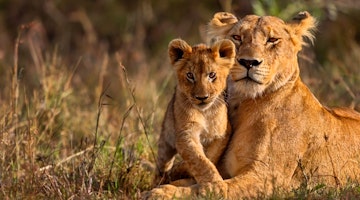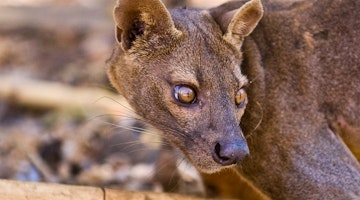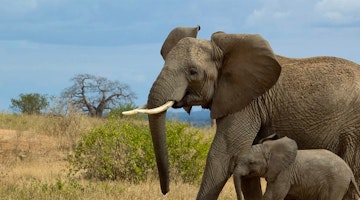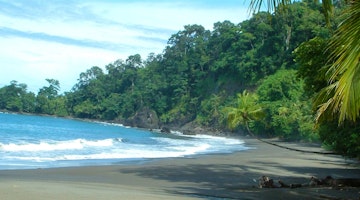The grasslands of the Kalahari and the moon-like landscape of Makgadikgadi salt pans make a striking contrast with the verdant, game-rich Okavango and Linyanti regions. In the dry season you can explore the vast expanse of the salt pans on light-weight quad bikes, enjoy breathtaking sunsets and learn survival skills from the local San Bushmen. Once part of a ‘super’ lake covering much of central Botswana, the salt pans fill with water in the rainy season, transforming from a harsh, arid landscape into a breading ground for huge flocks of flamingo and other migratory birds. The rains regenerate the grasses, which in turn attract a large migration of zebra and wildebeest. The Kalahari and the Makgadikgadi are a must for those who relish the opportunity to travel off-the-beaten track.
Kalahari Desert holidays
The word Kalahari is derived from the Tswana word Kgala meaning 'great thirst'. The Kalahari Desert is the largest sand basin in the world stretching 2,500kms from the northern regions of South Africa through to Namibia/Angola and ending in the Democratic Republic of Congo (DRC). It has vast areas covered by red sand without any permanent water.
The Central Kalahari Game Reserve (CKGR) is the largest game reserve in the world (52,800 sq km's) and for many years was closed to the public, hence it is know for being one of Africa's last true wild areas.
The term 'desert,' is however not quite accurate when referring to the Kalahari, the region receives an annual rainfall of 60mm-175mm, too high to be classified as a true desert. The Kalahari's vegetation consists of stunted thorn and scrub bush, as well as grasses and acacia's. There are over 400 identified plant species present.
Annual rain season is between December and March when summer temperatures can get quite high. About 1,100 meters above sea level – the largely unchanging flat terrain is occasionally wrinkled by gentle valleys, sand dunes and a large number of pans, which vary in size and complexity. These pans are invaluable to the wildlife as they supply them with nutrients from the salts and the grasses of the pans.
Wildlife in the Kalahari
Famous for being where the waters of the Okavango come to rest the Kalahari has been written about by several explorers, notably David Livingstone and more recently in Cry of the Kalahari by Mark and Delia Owens, during their time studying of the Brown Hyena.
The Central Kalahari Game Reserve is the annual destination for the migratory herds such zebra, wildebeest and springbok which come in their thousands. There are many lion in the area, especially the famous Kalahari black-maned lion, as well as leopard, jackals and cheetah. Brown hyenas and wild dogs can also be seen.
Several species of antelopes make the trip to the sweet grasses of the Central Kalahari Game Reserve which include hartebeest, kudu, duiker, eland, springbok, steenbok and gemsbok. Honey badgers are regular visitors as well as ground squirrels and colonies of meerkat - many an hour can be wiled away watching these fascinating animals as they forage and bask in the morning sunshine.
Bird life is rich with the world heaviest flying bird, the Kori Bustard, being common as well as the Black korhaan's continuous daytime calls. Ostrich are seen roaming free, usually in large flocks. All the sand grouse species of southern Africa live here. The Namaqua, which are a sight to see in the mornings, flock to the waterholes in their thousands to drink and bathe in the water holes. Raptors from the most common pale-chanting goshawk to the rock kestrel, bateleurs and brown and tawny eagles are also seen regularly.
Shelley Phillips
Travel Specialist
Looking for inspiration?
You'll find expert travel guides, holiday ideas and insider tips now on the Rainbow blog

Top 5 First Time Safari Destinations

10 Strange Animals and Where to Go to See them


Salar De Uyuni - The World's Largest Salt Flat


Top five South Africa Safari lodges

Sustainable Tourism In Corcovado National Park, Costa Rica

Why Choose Us?
Passionate travel experts
- We've been leading wildlife travel since our first South Africa tours over 25 years ago
- Our Travel Specialists have lived in their specialist area for years
- We work with local guides to immerse you deeper in our diverse range of experiences
Personal & tailor-made
- You'll speak to your own expert who'll share their first-hand knowledge
- We'll make your itinerary seamless with 24/7 emergency contact available
- Your Travel Specialist will listen to ensure you have the best chance of seeing the wildlife you love
Responsible by nature
- We take care to actively contribute to the conservation of environments we visit
- For select countries, we make a charitable donation on your behalf when you make your booking
- We've partnered with conservation experts and NGOs to curate responsible tours
For the latest travel advice from the Foreign, Commonwealth and Development Office check www.gov.uk/travelaware









